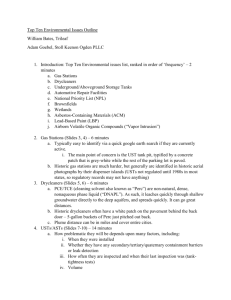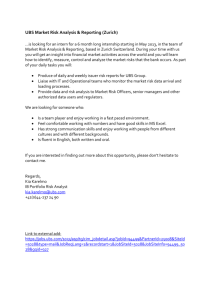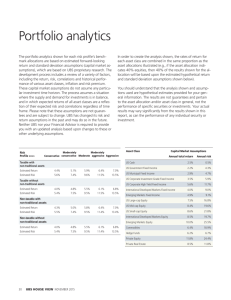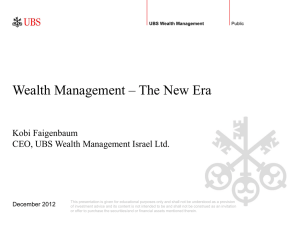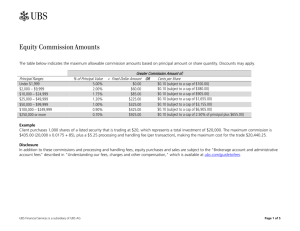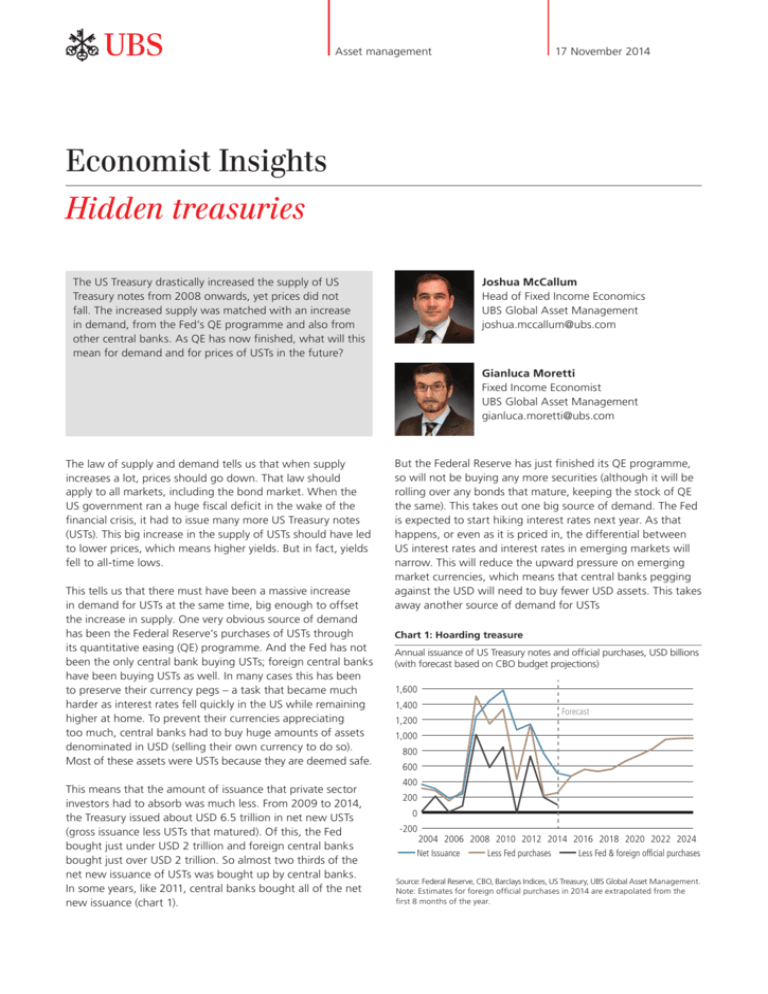
Asset management
17 November 2014
Economist Insights
Hidden treasuries
Joshua McCallum
Head of Fixed Income Economics
UBS Global Asset Management
joshua.mccallum@ubs.com
The US Treasury drastically increased the supply of US
Treasury notes from 2008 onwards, yet prices did not
fall. The increased supply was matched with an increase
in demand, from the Fed’s QE programme and also from
other central banks. As QE has now finished, what will this
mean for demand and for prices of USTs in the future?
Gianluca Moretti
Fixed Income Economist
UBS Global Asset Management
gianluca.moretti@ubs.com
The law of supply and demand tells us that when supply
increases a lot, prices should go down. That law should
apply to all markets, including the bond market. When the
US government ran a huge fiscal deficit in the wake of the
financial crisis, it had to issue many more US Treasury notes
(USTs). This big increase in the supply of USTs should have led
to lower prices, which means higher yields. But in fact, yields
fell to all-time lows.
This tells us that there must have been a massive increase
in demand for USTs at the same time, big enough to offset
the increase in supply. One very obvious source of demand
has been the Federal Reserve’s purchases of USTs through
its quantitative easing (QE) programme. And the Fed has not
been the only central bank buying USTs; foreign central banks
have been buying USTs as well. In many cases this has been
to preserve their currency pegs – a task that became much
harder as interest rates fell quickly in the US while remaining
higher at home. To prevent their currencies appreciating
too much, central banks had to buy huge amounts of assets
denominated in USD (selling their own currency to do so).
Most of these assets were USTs because they are deemed safe.
This means that the amount of issuance that private sector
investors had to absorb was much less. From 2009 to 2014,
the Treasury issued about USD 6.5 trillion in net new USTs
(gross issuance less USTs that matured). Of this, the Fed
bought just under USD 2 trillion and foreign central banks
bought just over USD 2 trillion. So almost two thirds of the
net new issuance of USTs was bought up by central banks.
In some years, like 2011, central banks bought all of the net
new issuance (chart 1).
But the Federal Reserve has just finished its QE programme,
so will not be buying any more securities (although it will be
rolling over any bonds that mature, keeping the stock of QE
the same). This takes out one big source of demand. The Fed
is expected to start hiking interest rates next year. As that
happens, or even as it is priced in, the differential between
US interest rates and interest rates in emerging markets will
narrow. This will reduce the upward pressure on emerging
market currencies, which means that central banks pegging
against the USD will need to buy fewer USD assets. This takes
away another source of demand for USTs
Chart 1: Hoarding treasure
Annual issuance of US Treasury notes and official purchases, USD billions
(with forecast based on CBO budget projections)
1,600
1,400
1,200
Forecast
1,000
800
600
400
200
0
-200
2004 2006 2008 2010 2012 2014 2016 2018 2020 2022 2024
Net Issuance
Less Fed purchases
Less Fed & foreign official purchases
Source: Federal Reserve, CBO, Barclays Indices, US Treasury, UBS Global Asset Management.
Note: Estimates for foreign official purchases in 2014 are extrapolated from the
first 8 months of the year.
So two sources of demand have gone, but what will happen
to supply? According the Congressional Budget Office (CBO),
a bipartisan research body for the US Congress, the US budget
deficit is going to reach its lowest level next year but will
start to rise thereafter. This increase is based upon current
legislation; the government could change its plans leading to a
lower (or even higher) deficit. Drastic changes look unlikely, so
the Treasury will probably be issuing more USTs in the future at
the same time as official demand shrinks.
If there is now going to be a big supply and demand
mismatch, does this mean that UST prices must fall and
push bond yields up? In the very short term (days or weeks),
mismatches between supply and demand can move UST
yields around. But longer term the effect is much smaller
because USTs are substitutes for other assets. If the price of
USTs falls enough, they start to look more attractive relative
to other riskier assets. Investors will sell those riskier assets
and buy USTs instead. Demand switches over from those
other assets into USTs.
Before the financial crisis, USTs made up about 25% of the US
bond market (chart 2). When government debt rose, the share
increased to about 40%. When the official sector holdings are
stripped out, the figures are more like 15% increasing to 23%,
a significantly smaller proportion initially and a significantly
smaller increase as well. But the thing about QE is that the
Fed creates new money to buy the bonds, so the investors
who sold their USTs end up with newly created cash in their
account. This is then used to buy other assets, which puts
downward pressure on the yields of those assets.
So what actually determines the price of USTs in the longer
run? Quite simply the price of the truly safe asset: the
overnight Fed Funds market. UST prices should be linked to
the expected path of the Fed funds rate (plus a risk premium
for the chance that the expectations are wrong), pretty much
regardless of supply and demand. The effect of increased
supply (net of purchases) is more likely to be felt in other,
riskier assets. But from here onwards, anyone who has been
hunting for treasuries for their portfolio should find them in
more plentiful supply.
Chart 2: Sharing the treasure
Treasuries as a share of US bond market, by face value
50
40
30
20
10
0
2004
Treasuries
2006
2008
Less Fed purchases
2010
2012
2014
Less Fed & foreign official purchases
Source: Bank of America/Merrill Lynch indices, Federal Reserve, US Treasury, UBS Global
Asset Management. Note: Bond market is defined as total of US high grade, US high
yield and US inflation linked markets. Fed and official purchases are deducted from
both the numerator and denominator.
The views expressed are as of November 2014 and are a general guide to the views of UBS Global Asset Management. This document does not replace portfolio
and fund-specific materials. Commentary is at a macro or strategy level and is not with reference to any registered or other mutual fund. This document is
intended for limited distribution to the clients and associates of UBS Global Asset Management. Use or distribution by any other person is prohibited. Copying any part of this
publication without the written permission of UBS Global Asset Management is prohibited. Care has been taken to ensure the accuracy of its content but no responsibility
is accepted for any errors or omissions herein. Please note that past performance is not a guide to the future. Potential for profit is accompanied by the possibility of loss.
The value of investments and the income from them may go down as well as up and investors may not get back the original amount invested. This document is a marketing
communication. Any market or investment views expressed are not intended to be investment research. The document has not been prepared in line with the requirements
of any jurisdiction designed to promote the independence of investment research and is not subject to any prohibition on dealing ahead of the dissemination of investment
research. The information contained in this document does not constitute a distribution, nor should it be considered a recommendation to purchase or sell any particular
security or fund. The information and opinions contained in this document have been compiled or arrived at based upon information obtained from sources believed to
be reliable and in good faith. All such information and opinions are subject to change without notice. A number of the comments in this document are based on current
expectations and are considered “forward-looking statements”. Actual future results, however, may prove to be different from expectations. The opinions expressed are
a reflection of UBS Global Asset Management’s best judgment at the time this document is compiled and any obligation to update or alter forward-looking statements as
a result of new information, future events, or otherwise is disclaimed. Furthermore, these views are not intended to predict or guarantee the future performance of any
individual security, asset class, markets generally, nor are they intended to predict the future performance of any UBS Global Asset Management account, portfolio or fund.
© UBS 2014. The key symbol and UBS are among the registered and unregistered trademarks of UBS. All rights reserved.
24152

